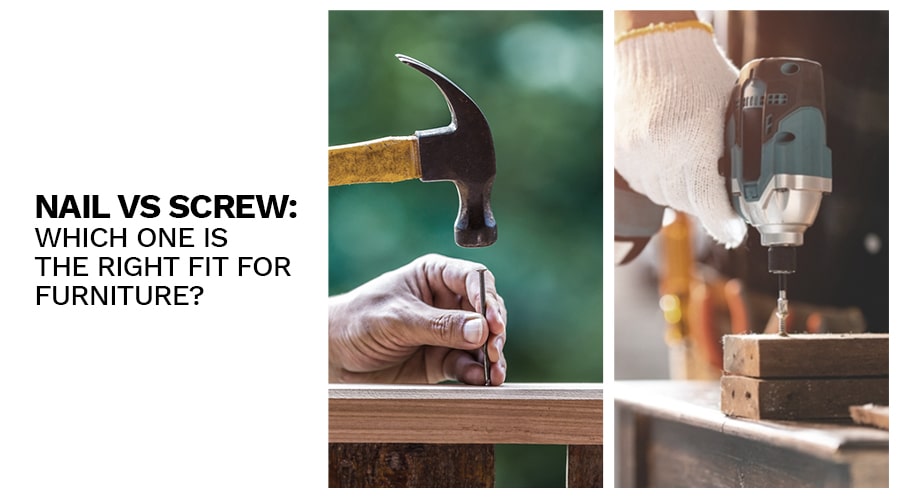


Among the stainless steel fastening solutions, there is always a heated debate as to which of the following: nail or screw is most suitable for furniture creation and why? The debate goes back decades and since then multiple views & points have been put forward without giving a clear winner. Let’s try to settle the exchange with a detailed discussion on the usage of nails vs furniture screws in furniture making.
Before we start jumping to a conclusion, let’s first understand the factors at play and discuss the important ones that will help us reach a solution.
It’s a well-known fact that nails are used for permanently joining or affixing two or more things, and furniture screws may be used in conjunction with nuts or bolts to form non-permanent joints. If the furniture requires permanent affixation, nails are the go to option, else screws may be used for a better grip. Also, if a joint undergoes frequent movement as in the case of wardrobe or door hinges, screws are a better option.
Nails are commonly made up of mild steel, aluminium & some other metals. While screws come in diverse options from brass, chrome coated, stainless steel or PVD
each material type has unique uses and also different physical & chemical properties.
Moisture, rust & water play a key role in determining the life of the joint. On a usual basis, nails are less protected from rust, corrosion or moisture. Furniture screws in general are made of stainless steel material that is less prone to these external factors & provides a long life.
This is one of the most practical things carpenters experience during usage, it is where claims are tested and reality is revealed. Nails have the tendency of bending if struck by a hammer at an improper angle, which also leads to their head bursting or splitting.
SS wooden screws, on the other hand, have different heads that make it possible for different screwdrivers to fasten them accurately in place without bursting.
With the rise of marketplaces like IKEA and the growing demand for modular Do IT Yourself furniture, it makes all the more sense to opt for furniture screws which allow disassembly & reassembly. Nails once fastened, cannot be reused again, resulting in being given less preference over their screw counterparts.
Coming to the technical part, nails have more shear strength and can deliver robust short to medium-term joints, and screws show more tensile strength, resulting in higher durability & reliability in the long run.
If drawer bottoms, small bookshelves, light furniture & cabinets are being made, nails can be a good option. But if it’s a load-heavy construction like school benches, tables, wardrobes, or modular kitchens then screws would do more justice. As a thumb rule, ss furniture screws have a higher load-bearing capacity.
Let’s be obvious, in developing markets like India, people are cost conscious. But cost should not make us choose the less preferred option by compromising on quality or usage. Nails, by default, are a cheaper option than screws but have their own unique utility in lightweight furniture. Screws tend to be costlier but come at the premium of handling greater weights.
Faster installation is always desired, that’s where nails take the edge, they have a slightly faster installation compared to screws. As for machine driveability, both nails & screws can be machine-driven into wooden furniture, plyboards & other types of material joints.
Nails typically come in a wide size range from 0.5 inches to 5 inches, while ss wooden screws come in a diverse variety from 0.25 inches to 4 inches with diameters or gauges between 2 to 16mm. The finishing in screws varies from gold, antique, copper, to nickel & stainless steel.
Coming to the big question, which between the nail or screw is a winner. Well, both have their unique utility and strengths including important factors like cost. But if long-run performance & strength is to be considered, then furniture screw emerges as the winner.
To witness the result first-hand, try the premium offerings from LP Screw, one of India’s leading furniture screw manufacturers. With a clientele across sectors and decades of experience, our quality screws pass the test of stress, performance & efficiency with flying colours.
We hope, with this write-up your confusion about the nail vs screw debate has been settled & an apt stainless steel fastener can be selected for your projects.